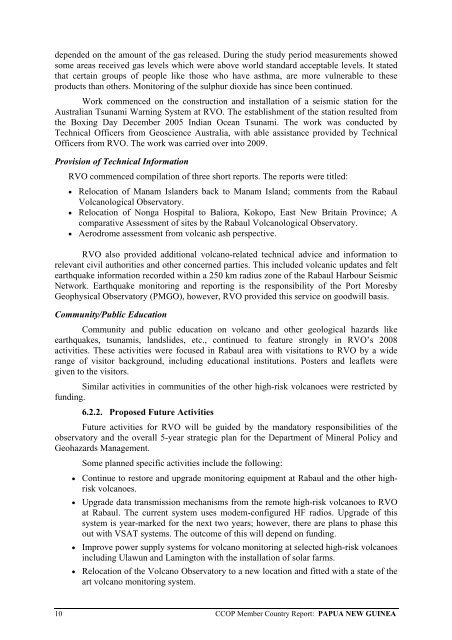Member Country Report of Papua New Guinea - CCOP
Member Country Report of Papua New Guinea - CCOP
Member Country Report of Papua New Guinea - CCOP
Create successful ePaper yourself
Turn your PDF publications into a flip-book with our unique Google optimized e-Paper software.
depended on the amount <strong>of</strong> the gas released. During the study period measurements showedsome areas received gas levels which were above world standard acceptable levels. It statedthat certain groups <strong>of</strong> people like those who have asthma, are more vulnerable to theseproducts than others. Monitoring <strong>of</strong> the sulphur dioxide has since been continued.Work commenced on the construction and installation <strong>of</strong> a seismic station for theAustralian Tsunami Warning System at RVO. The establishment <strong>of</strong> the station resulted fromthe Boxing Day December 2005 Indian Ocean Tsunami. The work was conducted byTechnical Officers from Geoscience Australia, with able assistance provided by TechnicalOfficers from RVO. The work was carried over into 2009.Provision <strong>of</strong> Technical InformationRVO commenced compilation <strong>of</strong> three short reports. The reports were titled:• Relocation <strong>of</strong> Manam Islanders back to Manam Island; comments from the RabaulVolcanological Observatory.• Relocation <strong>of</strong> Nonga Hospital to Baliora, Kokopo, East <strong>New</strong> Britain Province; Acomparative Assessment <strong>of</strong> sites by the Rabaul Volcanological Observatory.• Aerodrome assessment from volcanic ash perspective.RVO also provided additional volcano-related technical advice and information torelevant civil authorities and other concerned parties. This included volcanic updates and feltearthquake information recorded within a 250 km radius zone <strong>of</strong> the Rabaul Harbour SeismicNetwork. Earthquake monitoring and reporting is the responsibility <strong>of</strong> the Port MoresbyGeophysical Observatory (PMGO), however, RVO provided this service on goodwill basis.Community/Public EducationCommunity and public education on volcano and other geological hazards likeearthquakes, tsunamis, landslides, etc., continued to feature strongly in RVO’s 2008activities. These activities were focused in Rabaul area with visitations to RVO by a widerange <strong>of</strong> visitor background, including educational institutions. Posters and leaflets weregiven to the visitors.Similar activities in communities <strong>of</strong> the other high-risk volcanoes were restricted byfunding.6.2.2. Proposed Future ActivitiesFuture activities for RVO will be guided by the mandatory responsibilities <strong>of</strong> theobservatory and the overall 5-year strategic plan for the Department <strong>of</strong> Mineral Policy andGeohazards Management.Some planned specific activities include the following:• Continue to restore and upgrade monitoring equipment at Rabaul and the other highriskvolcanoes.• Upgrade data transmission mechanisms from the remote high-risk volcanoes to RVOat Rabaul. The current system uses modem-configured HF radios. Upgrade <strong>of</strong> thissystem is year-marked for the next two years; however, there are plans to phase thisout with VSAT systems. The outcome <strong>of</strong> this will depend on funding.• Improve power supply systems for volcano monitoring at selected high-risk volcanoesincluding Ulawun and Lamington with the installation <strong>of</strong> solar farms.• Relocation <strong>of</strong> the Volcano Observatory to a new location and fitted with a state <strong>of</strong> theart volcano monitoring system.10 <strong>CCOP</strong> <strong>Member</strong> <strong>Country</strong> <strong>Report</strong>: PAPUA NEW GUINEA
















